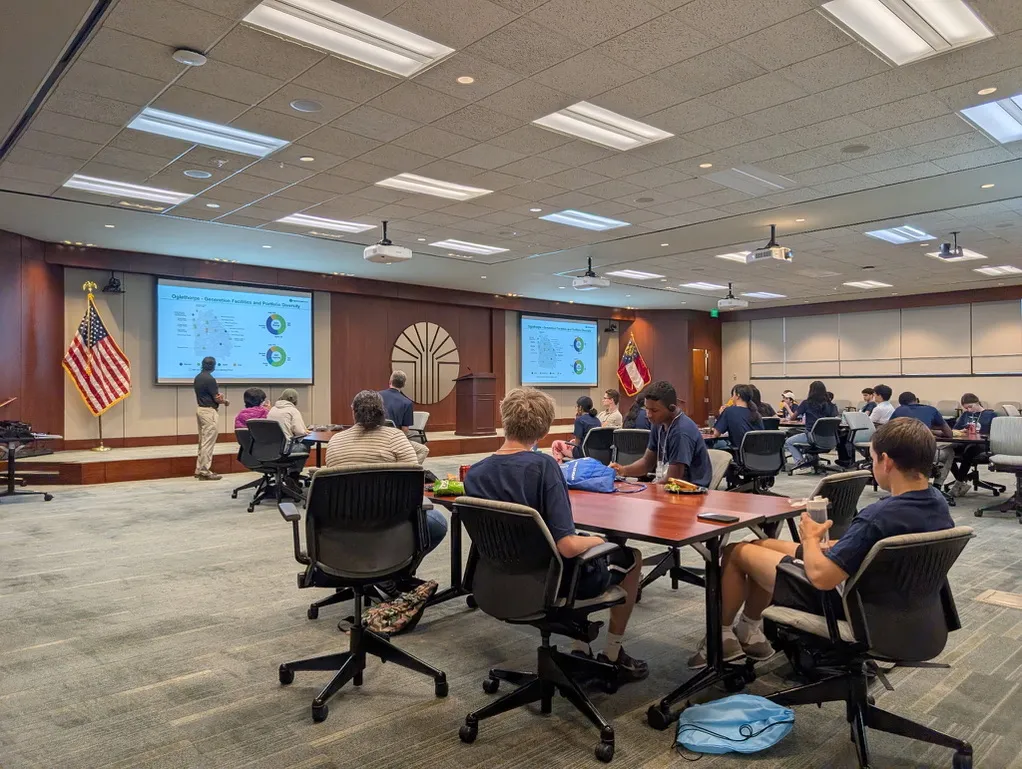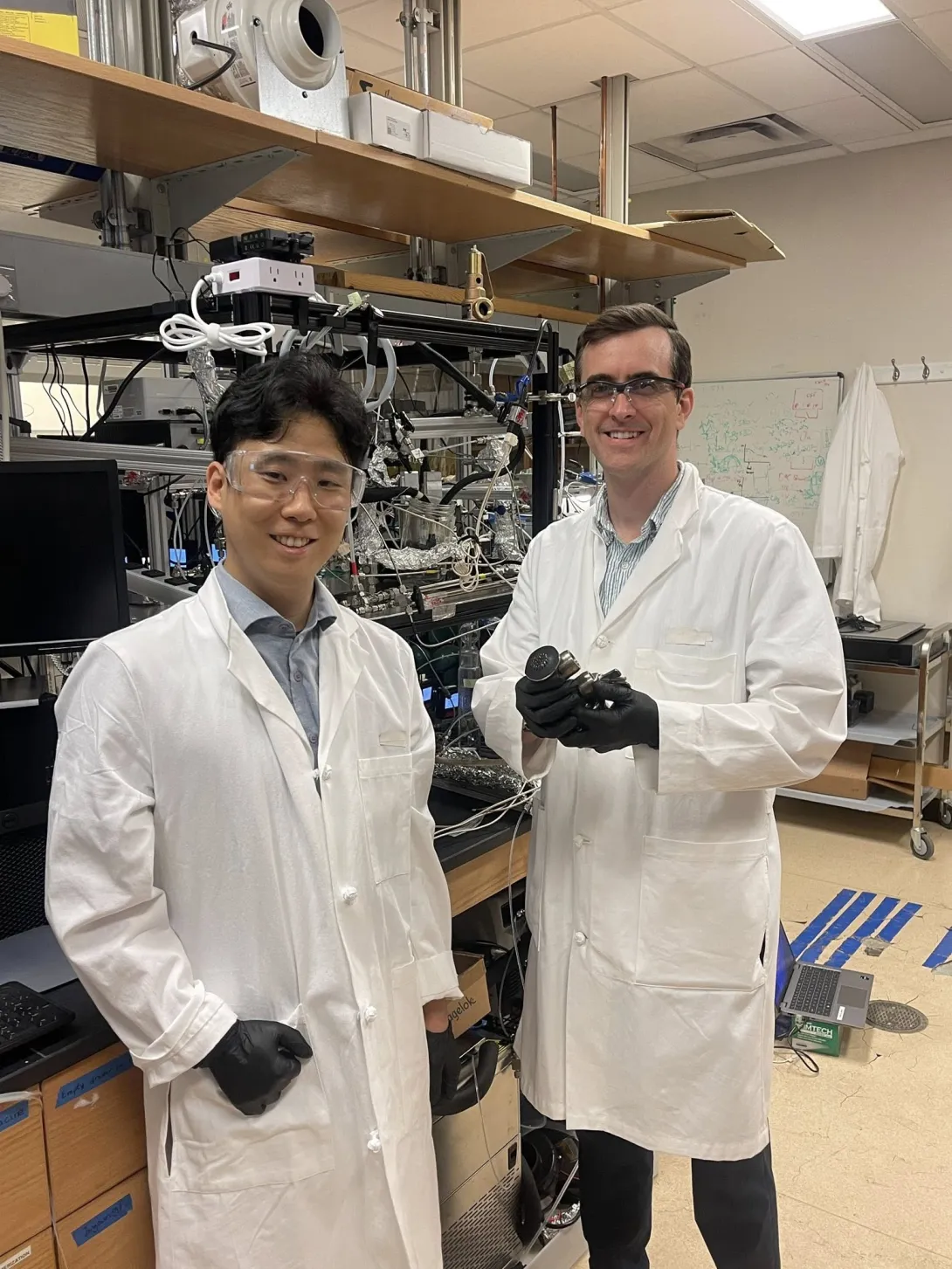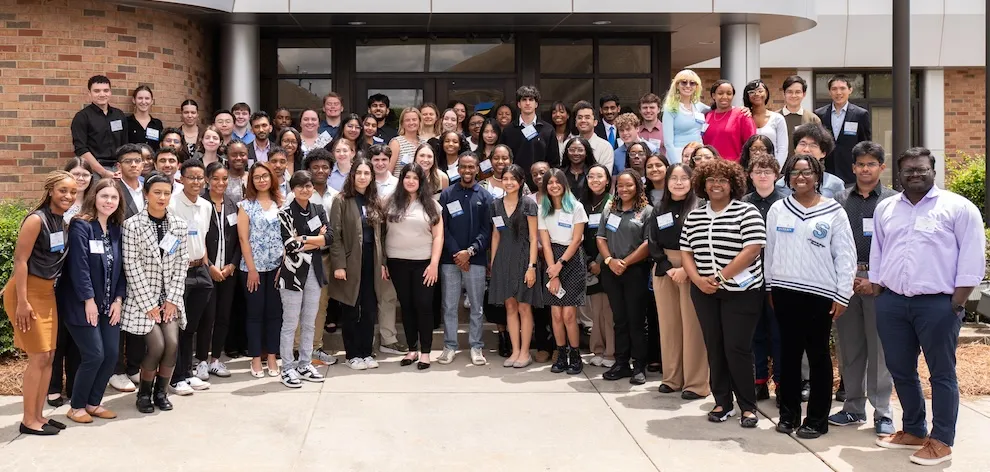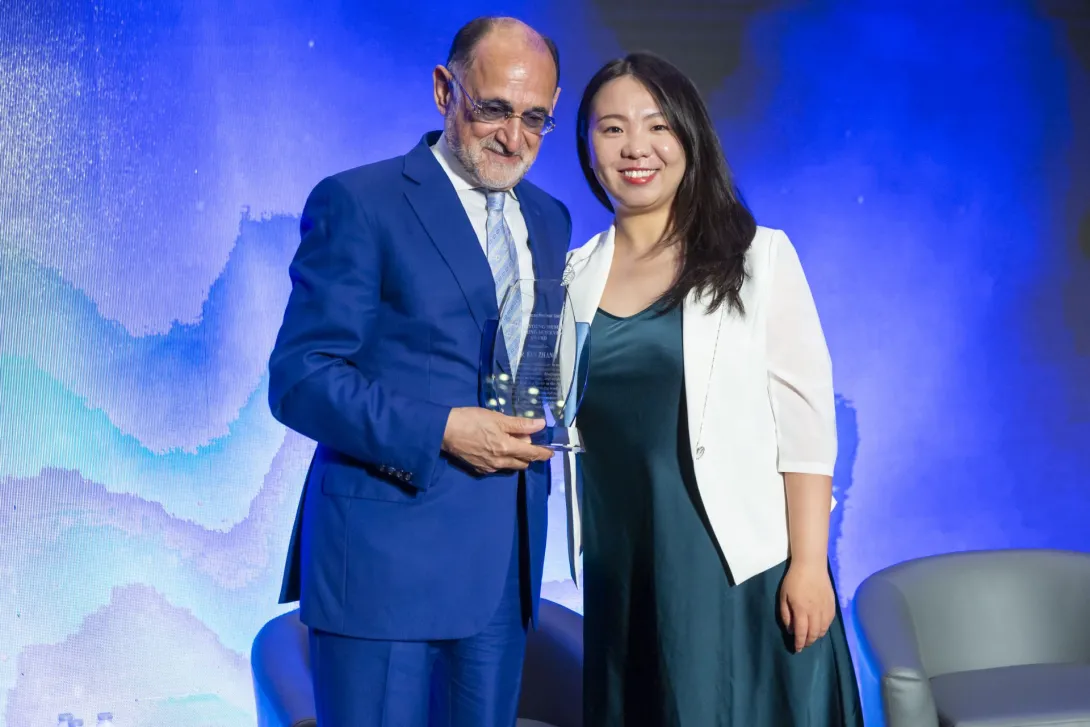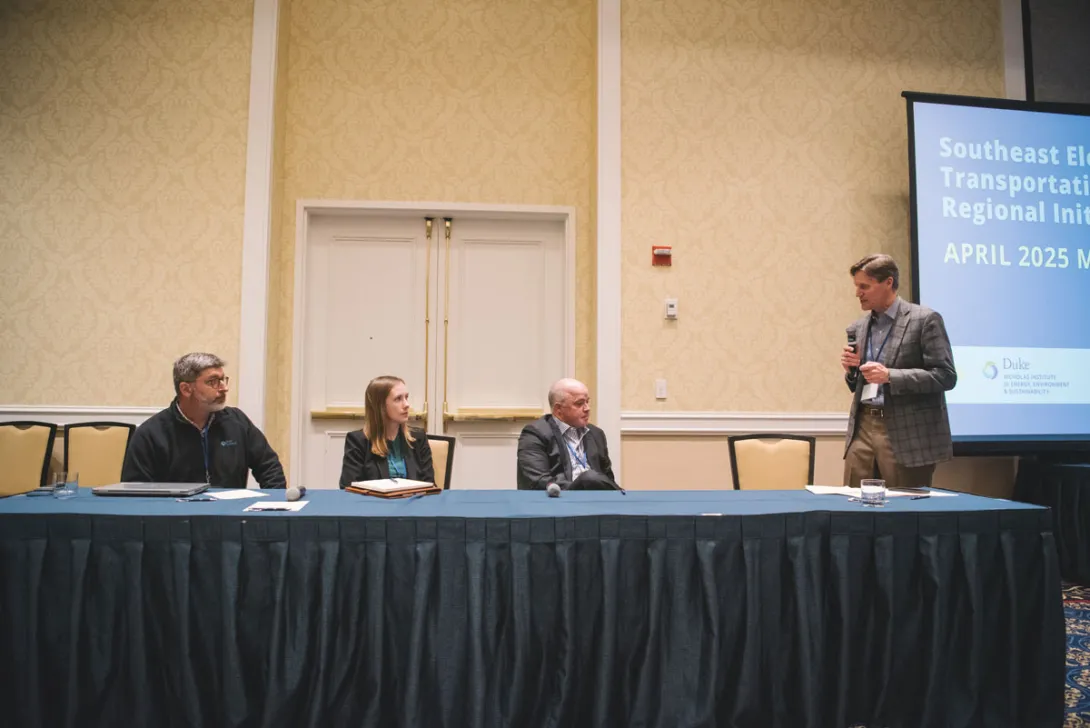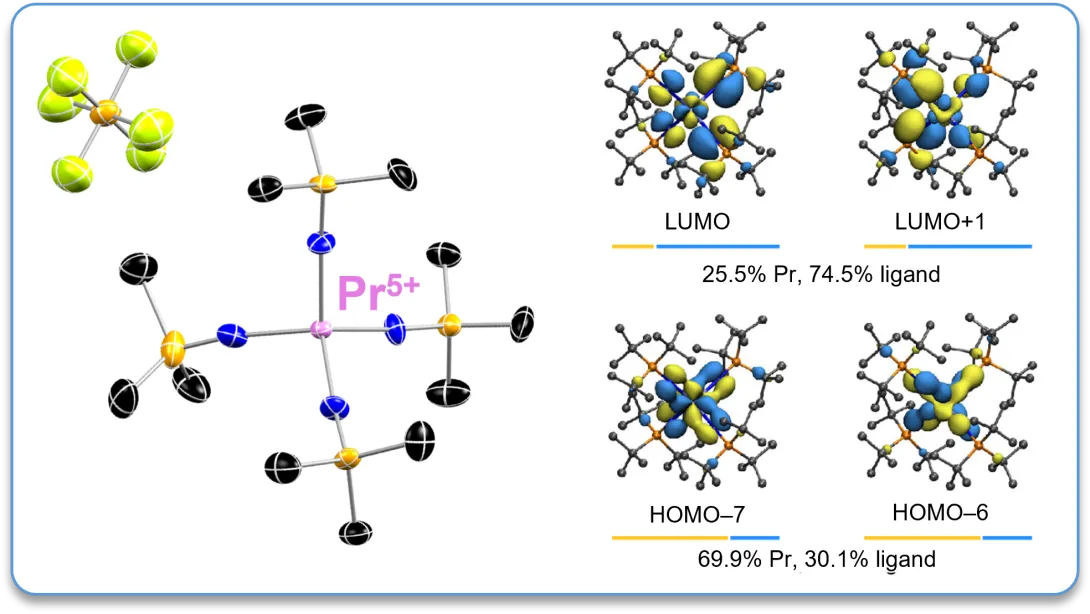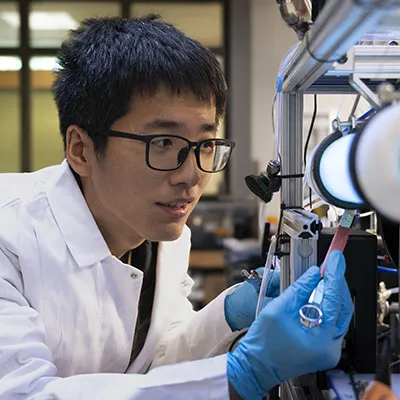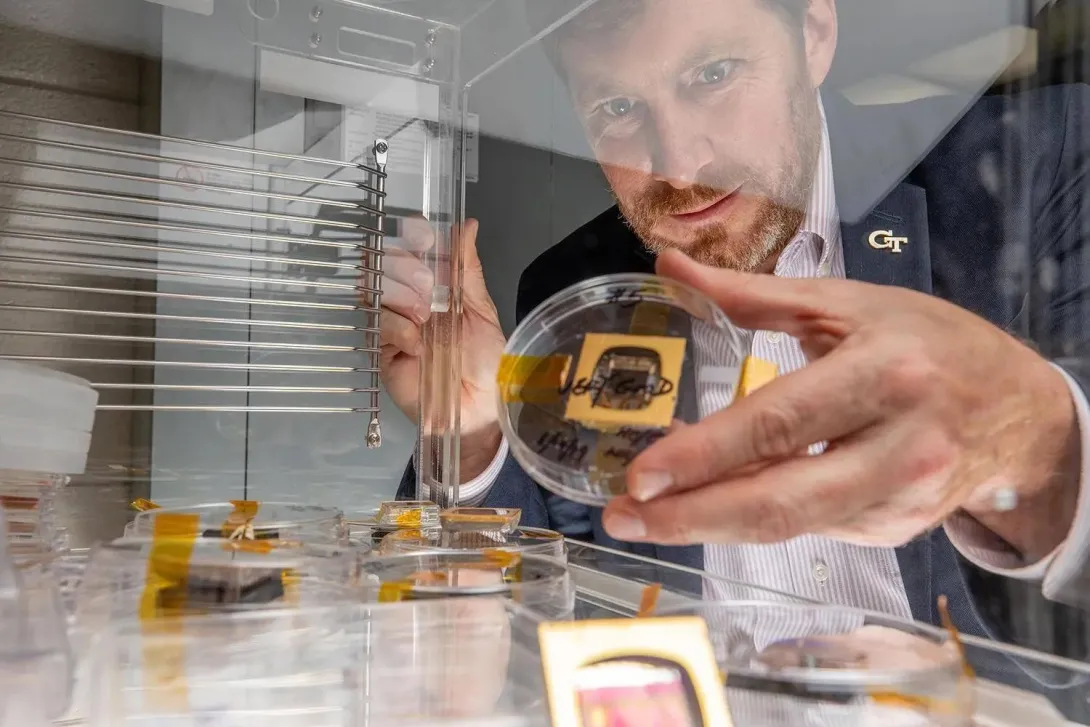Jul. 10, 2025
In June, Georgia Tech’s Strategic Energy Institute (SEI) and the Energy Policy and Innovation Center hosted Energy Unplugged, a weeklong summer camp focused on science, technology, engineering, art, and mathematics (STEAM) for high school students.
Led by SEI’s director of Research and Studies and principal research engineer, Richard Simmons, the camp introduced students to energy fundamentals and highlighted STEAM-related careers and undergraduate pathways valuable in today’s workforce. The curriculum included energy resources, energy production and consumption, conversion and delivery, electric circuits, battery storage, environmental impacts, and data analytics.
As a featured part of this year’s program, students visited the headquarters of Oglethorpe Power, Green Power EMC, and Georgia System Operations Corporation in Tucker, Georgia. The companies are owned by and serve 38 of Georgia’s not-for-profit electric membership cooperatives (EMCs), which provide retail electricity to approximately 4.7 million of Georgia’s more than 11 million residents.
“As electricity demand continues to rise, so does the need to grow a skilled and capable workforce for the future. We are proud to partner with Georgia Tech on this inspiring program, supporting the growth and development of the next generation of leaders who will help power Georgia’s future,” said George Mathai, Oglethorpe Power performance and reliability engineer.
The site visit included a tour of Georgia System Operations’ generation and transmission control centers and presentations by Oglethorpe Power and Green Power EMC experts.
The tour began in the generation control center, where students observed operators continuously monitoring demand to make real-time decisions to increase or decrease electricity generation. Students learned that Georgia System Operations dispatches a wide array of energy sources and generation technologies to ensure a stable, reliable, secure, and efficient power grid.
The group then visited the transmission control center, where a series of massive screens showed the web of transmission lines across the state. Students learned that the transmission system relies on extremely high-voltage lines to minimize loss across long distances. The voltages are then stepped down as they approach population centers at sub-stations, so they are suitable for use by residences, businesses, and industrial facilities. The operators in the transmission center monitor the grid for disturbances and respond to alarms, maintaining the integrity of the state’s power infrastructure.
The tour offered a behind-the-scenes look at how electricity generation and transmission are integrated and managed across the state.
Over lunch, Oglethorpe Power’s George Mathai and Shane Tolbert, Green Power EMC’s distributed energy resources manager, led discussions highlighting the roles of various generation sources and the benefits of a diverse portfolio in balancing cost, reliability, sustainable resources, and environmental impact.
“Learning about how Oglethorpe Power, Green Power EMC, and Georgia System Operations work together was a highlight of the Energy Unplugged camp, as it reinforced many of the tabletop demonstrations and hands-on activities we had conducted in the days leading up to the visit. When students then get a chance to visualize energy production, conversion, and delivery concepts at full scale, lots of light bulbs start clicking on,” Simmons said.
Jointly contributed by:
Oglethorpe Power Corporation
Georgia Tech Strategic Energy Institute (Destin Smyth)
News Contact
Priya Devarajan, Communications Program Manager,
Georgia Tech Strategic Energy Institute
Blair Romero, Director, Corporate Communications
Oglethorpe Power Corporation
Jul. 07, 2025
Researchers at Georgia Tech’s School of Chemical and Biomolecular Engineering (ChBE) have developed a promising approach for removing carbon dioxide (CO₂) from the atmosphere to help mitigate global warming.
While promising technologies for direct air capture (DAC) have emerged over the past decade, high capital and energy costs have hindered DAC implementation.
However, in a new study published in Energy & Environmental Science, the research team demonstrated techniques for capturing CO₂ more efficiently and affordably using extremely cold air and widely available porous sorbent materials, expanding future deployment opportunities for DAC.
Harnessing Already Available Energy
The research team – including members from Oak Ridge National Laboratory in Tennessee and Jeonbuk National University and Chonnam National University in South Korea – employed a method combining DAC with the regasification of liquefied natural gas (LNG), a common industrial process that produces extremely cold temperatures.
LNG, which is a natural gas cooled into a liquid for shipping, must be warmed back into a gas before use. That warming process often uses seawater as the source of the heat and essentially wastes the low temperature energy embodied in the liquified natural gas.
Instead, by using the cold energy from LNG to chill the air, Georgia Tech researchers created a superior environment for capturing CO₂ using materials known as “physisorbents,” which are porous solids that soak up gases.
Most DAC systems in use today employ amine-based materials that chemically bind CO2 from the air, but they offer relatively limited pore space for capture, degrade over time, and require substantial energy to operate effectively. Physisorbents, however, offer longer lifespans and faster CO₂ uptake but often struggle in warm, humid conditions.
The research study showed that when air is cooled to near-cryogenic temperatures for DAC, almost all of the water vapor condenses out of the air. This enables physisorbents to achieve higher CO₂ capture performance without the need for expensive water-removal steps.
“This is an exciting step forward,” said Professor Ryan Lively of ChBE@GT. “We’re showing that you can capture carbon at low costs using existing infrastructure and safe, low-cost materials.”
Cost and Energy Savings
The economic modeling conducted by Lively’s team suggests that integrating this LNG-based approach into DAC could reduce the cost of capturing one metric ton of CO₂ to as low as $70, approximately a threefold decrease from current DAC methods, which often exceed $200 per ton.
Through simulations and experiments, the team identified Zeolite 13X and CALF-20 as leading physisorbents for this DAC process. Zeolite 13X is an inexpensive and durable desiccant material used in water treatment, while CALF-20 is a metal-organic framework (MOF) known for its stability and CO2 capture performance from flue gas, but not from air.
These materials showed strong CO₂ adsorption at -78°C (a representative temperature for the LNG-DAC system) with capacities approximately three times higher than those found in amine materials that operate at ambient conditions. They also released the captured and purified CO₂ with low energy input, making them attractive for practical use.
“Beyond their high CO2 capacities, both physisorbents exhibit critical characteristics such as low desorption enthalpy, cost efficiency, scalability, and long-term stability, all of which are essential for real-world applications,” said lead author Seo-Yul Kim, a postdoctoral researcher in the Lively Lab.
Leveraging Existing Infrastructure
The study also addresses a key concern for DAC: location. Traditional systems are often best suited for dry, cool environments. But by leveraging existing LNG infrastructure, near-cryogenic DAC could be deployed in temperate and even humid coastal regions, greatly expanding the geographic scope of carbon removal.
“LNG regasification systems are currently an untapped source of cold energy, with terminals operating at a large scale in coastal areas around the world,” Lively said. “By harnessing even just a portion of their cold energy, we could potentially capture over 100 million metric tons of CO₂ per year by 2050.”
As governments and industries face increasing pressure to meet net-zero emissions goals, solutions like LNG-coupled near-cryogenic DAC offer a promising path forward. The next steps for the team include continued refinement of materials and system designs to ensure performance and durability at larger scales.
“This is an exciting example of how rethinking energy flows in our existing infrastructure can lead to low-cost reductions in carbon footprint,” Lively said.
The study also demonstrated that an expanded range of materials could be employed for DAC. While only a small subset of materials can be used at ambient temperatures, the number that are viable grows substantially at near-cryogenic temperatures.
“Many physisorbents that were previously dismissed for DAC suddenly become viable when you drop the temperature,” said Professor Matthew Realff, co-author of the study and professor at ChBE@GT. “This unlocks a whole new design space for carbon capture materials.”
Citation: Seo-Yul Kim, Akriti Sarswat, Sunghyun Cho, MinGyu Song, Jinsu Kim, Matthew J. Realff, David S. Sholl, and Ryan P. Lively, “Near-Cryogenic Direct Air Capture using Adsorbents,” Energy & Environmental Science, 2025.
News Contact
Brad Dixon, braddixon@gatech.edu
Jul. 02, 2025
The Partnership for Inclusive Innovation launched the sixth annual PIN Summer Intern (PSI) program in May with an event at Fort Valley State University’s location in Warner Robins, Georgia. The program is shaping up to be the biggest yet.
This summer, 103 students are working on 51 projects across 27 communities in Georgia, Alabama, Virginia, and Texas. Selected from nearly 700 applicants — a 73% increase over last year — these students are tackling real-world challenges ranging from AI applications in North Georgia to Native American initiatives in Whigham, Georgia, and Bracketville, Texas.
By pairing students from different years, majors and institutions, the PSI program gives the next generation of innovators hands-on experience addressing complex challenges while delivering practical solutions to communities across the region.
A collaboration with the Southeast Crescent Regional Commission (SCRC) has funded 17 projects in several counties in Middle and South Georgia and is a large part of the program’s expansion this year. The opportunity to make an impact across a broad swath of Georgia is part of why the SCRC was interested in working with PIN, said SCRC Executive Director Christopher McKinney.
News Contact
Karen Kirkpatrick (karen.kirkpatrick@innovate.gatech.edu)
Jul. 01, 2025
Fan Zhang, assistant professor in the George W. Woodruff School of Mechanical Engineering, has received the 2025 Landis Young Member Engineering Achievement Award from the American Nuclear Society (ANS).
The award recognizes young members for outstanding achievements in which engineering knowledge is effectively applied to yield an engineering concept, design, safety improvement, method of analysis, or product utilized in nuclear power research and development or commercial application.
Zhang was selected by the ANS Honors and Awards Committee for her pioneering contributions to nuclear cybersecurity through innovative machine learning (ML) approaches, development of patent-pending technology, and efforts to establish Georgia Tech as a leader in the field. The award also recognizes her collaboration with the International Atomic Energy Agency and her groundbreaking research on robot-assisted nuclear power plant monitoring, which improves safety and efficiency and demonstrates exceptional impact on global nuclear security.
Zhang serves as the director of the Intelligence for Advanced Nuclear (iFAN) Lab at Georgia Tech. Her research primarily focuses on nuclear cybersecurity, online monitoring, fault detection, digital twins, AI/ML, and robotics. Her work on robot-assisted nuclear power plant monitoring, which combines these cross-cutting areas, could significantly reduce human worker presence in harsh and potentially hazardous environments and improve the efficiency of plant operation. The work was supported by the inaugural Department of Energy Office of Nuclear Energy Distinguished Early Career Award.
News Contact
Jun. 27, 2025
More than 70 people convened at Duke University and virtually on April 3 to highlight successes, challenges and opportunities across research, industry and policy on regional electric mobility in the Southeast.
The April 2025 Southeast Electric Transportation Regional Initiative (SETRI) meeting provided an information-sharing forum for a multisector group of electric mobility organizations from across the region. SETRI is a collaborative network connecting, informing and advancing transportation electrification in the Southeast. The event was hosted by the Duke University Nicholas Institute for Energy, Environment & Sustainability and Georgia Tech Strategic Energy Institute, in collaboration with SETRI partner organizations.
“Bringing this multisector community together is important to share ideas on how to best advance electric mobility—a key emerging industry in the southeastern United States and important strategy for reducing transportation emissions,” said Trey Gowdy, Nicholas Institute research lead and SETRI co-facilitator.
Throughout the morning, speakers shared insights about the electric vehicle (EV) landscape in North Carolina and throughout the Southeast, the state of the EV market and manufacturing, charging infrastructure, consumer education and local engagement and more. The event also featured a poster session, networking and an electric vehicle display.
SETRI organizers announced during the meeting that the Southeast Portal for Electric Transportation Opportunities has shared more than 500 opportunities since launching two years ago. The portal lists active funding sources, comment solicitations, research opportunities, events and other timely information related to transportation electrification in the region.
“A focus of the SETRI network has been to deepen connections within our region, with the aim of accelerating progress between utilities, charging companies, investors, NGOs and universities. It was great to be in Durham after our session in Atlanta last year,” said Richard Simmons, principal research engineer at the Georgia Tech Strategic Energy Institute and SETRI co-facilitator.
Read Full Story on the Duke Nicholas Institute for Energy, Environment and Sustainability Newspage
News Contact
Priya Devarajan || Research Communications Program Manager, SEI
Jun. 26, 2025
Solar cells account for approximately six percent of the electricity used on Earth; however, in space, they play a significantly larger role, with nearly all satellites relying on advanced solar cells for their power. That’s why Georgia Tech researchers will soon send 18 photovoltaic cells to the International Space Station for a study of how space conditions affect the devices’ operation over time.
“The main goal here is to improve power generation in space,” said Jud Ready, principal research engineer at the Georgia Tech Research Institute (GTRI) and Executive Director of Georgia Tech's Space Research Institute. “The limiting factor on the performance of a spacecraft is usually how much power you can produce. Power, size, weight, complexity, cost – all of these are tied closely to the electrical generation of the solar panels.”
News Contact
Media Inquiries: gtri.media@gtri.gatech.edu
Writer: John Toon (john.toon@gtri.gatech.edu)
GTRI Communications
Georgia Tech Research Institute
Atlanta, Georgia USA
Jun. 24, 2025
A longstanding mystery of the periodic table involves a group of unique elements called lanthanides. Also known as rare earth elements, or REEs, these silvery-white metals are challenging to isolate, given their very similar chemical and physical properties. This similarity makes it difficult to distinguish REEs from one other during extraction and purification processes.
The world has come to depend on lanthanides’ magnetic and optical properties to drive much of modern technology — from medical imaging to missiles to smart phones. These metals also are in short supply, and because they’re found in minerals, lanthanides are difficult to mine and separate. But that may change — thanks to a Georgia Tech-led discovery of a new oxidation state for a lanthanide element known as praseodymium.
For the first time ever, praseodymium achieved a 5+ oxidation state. Oxidation occurs when a substance meets oxygen or another oxidizing substance. (The browning on the flesh of a cut apple, as well as rust on metal, are examples of oxidation.)
As far back as the 1890s, scientists suspected lanthanides might have a 5+ oxidation state, but lanthanides in that state were too unstable to see, said Henry ”Pete“ La Pierre, an associate professor in Georgia Tech’s School of Chemistry and Biochemistry. Discovering an element’s new oxidation state is like discovering a new element. As an example, La Pierre noted how plutonium’s discovery opened up a whole new area of the periodic table.
“A new oxidation state tells us what we don’t know and gives us ideas for where to go,” he explained. “Each oxidation state of an element has distinct chemical and physical properties — so the first glimpse of a novel oxidation presents a roadmap for new possibilities.”
La Pierre and colleagues at University of Iowa and Washington State University recently discovered the 5+ oxidation state for lanthanides.
“It was predicted but never seen until we found it,” said La Pierre, corresponding author of the study, “Praseodymium in the Formal +5 Oxidation State,” which was recently published in Nature Chemistry. “Lanthanides’ properties are really fantastic. We only use them commercially in one oxidation state — the 3+ oxidation state — which defines a set of magnetic and optical properties. If you can stabilize a higher oxidation state, it could lead to entirely new magnetic and optical properties.”
The researchers’ breakthrough will broaden the lanthanides’ technical applications in fields such as rare-earth mining and quantum technology and could lead to new electronic device architectures and applications.
“Research in lanthanides has already yielded significant dividends for society in terms of technological development,” La Pierre added.
The researchers hope to discover new tools for mining critical REEs, including improving lanthanide separation and recycling processes. When mining these elements, lanthanide elements are frequently mixed together. The separation process is painstaking and inefficient, generating a significant amount of waste. But with increasing global demand for REEs, the U.S. faces a supply issue. Figuring out how to improve lanthanides separation, potentially through oxidation chemistry, will ultimately enhance the supply of these critical elements.
— Anne Wainscott-Sargent
Funding: This research was supported by grants from the National Science Foundation and the U.S. Department of Energy.
News Contact
Shelley Wunder-Smith
Director of Research Communications
Jun. 24, 2025
Imagine boarding a jet in Atlanta and arriving in Japan in about the time it takes now to fly to Miami or Chicago.
That’s just one of the possibilities of research in an area of ultrafast flight called hypersonics. The term refers to traveling at roughly a mile a second, or about five times the speed of sound and faster.
Interest in hypersonics is growing, with early notions of high-speed passenger travel alongside defense and space applications driving questions about meeting the demands of Mach 5+ flight.
Such speeds introduce a host of new challenges for aerodynamics, thermal management, and rapid decision-making that Georgia Tech engineers are working to solve.
For Anirban Mazumdar in the George W. Woodruff School of Mechanical Engineering, aerospace questions have always been fascinating.
Hypersonics is an area where those questions are tough. Uncovering answers can have real impact on unlocking new capabilities for travel across the globe or to space, in addition to national security implications.
“It’s very challenging. We are trying to deal with very extreme scenarios, and we’re trying to do it, not just to advance science, but primarily because it matters to our country,” Mazumdar said. “That combination is incredible.”
News Contact
By: Joshua Stewart (jstewart@gatech.edu)
Jun. 12, 2025
As the planet warms, changing weather patterns are only one effect. Warming air is often more toxic, leading to asthma and even heart attacks. A better understanding of these air quality changes can help society mitigate their consequences. Georgia Tech researchers are innovating ways to study air quality — beginning with prehistoric insights and zooming all the way to satellites in our orbit.
May. 27, 2025
Space researcher. Materials scientist. Entrepreneur. And Yellow Jacket. The only thing missing on Jud Ready’s resume is “astronaut.” Not for lack of trying, though. Ready had hoped earning his bachelor’s, master’s, and doctoral degrees in materials science and engineering at Georgia Tech would lead him to a spot in NASA’s Astronaut Corps. Instead, it’s led him to the Georgia Tech Research Institute (GTRI), where his passion for space is alive and well.
1. What about space fascinates you?
It all goes back to my dad being interested in space. In first grade, we went to a how-to-use-the-library class, and I came across a book about the Mercury and Apollo astronauts. I checked it out and renewed it over and over again. I eventually finished it in second grade. So, I’ve had a lifelong commitment since then to space.
2. What drew you to engineering?
I grew up in Chapel Hill. In that same first grade class, we went to the University of North Carolina chemistry department. My mom is really into roses, and they froze a rose in liquid nitrogen then smashed it on the table. It broke into a million bits, and I was like, “What?!” The ability of science to solve the unknown grabbed me. And I had a series of very good science teachers — Mr. Parker in fifth grade, in particular. Then I took a soldering class in high school. We built a multimeter that I still have and still use, and various other things. And I suddenly discovered and started exploring engineering. Plus, I just like making things.
3. How did your career change from hoping to be an astronaut to being an accomplished materials engineer?
When I started looking at colleges, that was my primary interest: What school would help me become an astronaut the quickest. I applied to Georgia Tech as an aerospace engineer, but was admitted as an undecided engineering candidate instead. It was the best thing that could have happened. Later, I got hired as an undergrad by a professor who was doing space-grown gallium arsenide on the Space Shuttle. Ultimately, they offered me a graduate position. I accepted, because I knew you needed an advanced degree to be an astronaut — and for a civilian, a Ph.D. in a relevant career such as materials science.
I applied so many times to be an astronaut — every time they opened a call from 1999 until just a few years ago. Never got in. But I was successful at writing proposals and teaching. So I started doing space vicariously through my students, writing research proposals on energy capture, such as solar cells; energy storage, such as super capacitors; and energy delivery like electron emission. They’re all enabled by engineered materials.
4. What makes Georgia Tech and GTRI a key contributor to the future of humans and science in space?
Georgia Tech offers us so many unfair advantages over our competition. The equipment we’ve got. The students. You’ve got the curiosity-driven basic research coupled with the GTRI applied research model. We’ve had VentureLab and CREATE-X. Now we’ve got Quadrant-i to foster spinout companies from research.
5. One of your solar cell technologies is headed to the Smithsonian National Air & Space Museum. What is it?
Early in my career, we developed a way to texture thin film photovoltaics to allow for light trapping. Inverted pyramids are etched into silicon wafer-type solar cells so a photon of light has a chance to hit different surfaces and get absorbed. But thin film solar cells typically don’t etch well. I thought we could use carbon nanotubes to form a scaffolding, a structure like rebar. It’s mechanically reinforcing, but also electrically conductive. We coat the thin film solar cell material over the carbon nanotube arrays. You’ve got these towers, and you get this photon pinballing effect. Most solar cells perform best when perpendicular to the sun, but with mine, off angles are preferred. That’s great for orbital uses, because the faces and solar panels of spacecraft are frequently off-angle to the sun. And then you don’t have the complexity of mechanical systems adjusting the solar arrays. So, we got funding to demonstrate these solar cells on the International Space Station three times, and those are some of the cells we provided to the Smithsonian.
News Contact
Joshua Stewart (jstewart@gatech.edu)
Assistant Director of Communications,
College of Engineering, Georgia Tech
Pagination
- 1 Page 1
- Next page
